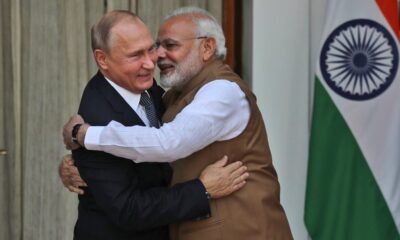Science
Russia to Transform Spacecraft into Advertising Platforms

Russia’s civilian space program is undergoing a significant transformation as President Vladimir Putin recently approved a plan to allow advertising on Russian spacecraft. This decision comes amid a challenging period for the country’s space endeavors, marked by a reduction in crewed missions and a stalled replacement for the aging Soyuz spacecraft.
The changes, announced by the Roscosmos State Corporation for Space Activities on its official Telegram account, will permit the placement of advertisements on state-owned space objects starting from January 1, 2026. According to Roscosmos, this initiative aims to attract private investment in Russian space exploration while alleviating some financial pressure from the state budget.
The amendments to federal laws governing advertising and space activities received approval from the Russian State Duma, which is largely loyal to Putin. Roscosmos noted that the advertising must not compromise the safety of the spacecraft. Although the specifics of the fee structure for advertising have yet to be disclosed, it is likely that only Russian entities and allies will be eligible to participate, given the sanctions imposed by Western nations following the invasion of Ukraine in February 2022.
This shift towards commercial advertising in space is not entirely new. In the past, Russian rockets have often featured logos representing customers and suppliers. For instance, during significant anniversaries, rockets have been adorned with commemorative symbols, such as the 60th anniversary of Yuri Gagarin‘s historic flight and the 80th anniversary of the end of World War II. However, the idea of placing commercial advertisements on spacecraft is relatively rare.
One notable instance occurred in 2000 when Pizza Hut reportedly paid $1 million to display its logo on a Proton rocket, which launched a module for the International Space Station. While the concept of orbiting advertisements visible from Earth has been proposed, it has not advanced beyond theoretical discussions.
Despite the potential for new revenue streams, the advertising market in space has not yet thrived, and prospects for its growth in Russia seem uncertain. The head of Russia’s main spacecraft manufacturer, RSC Energia, issued a stark warning in August about the dire state of the industry. Igor Maltsev highlighted the company’s struggles to pay wages and fulfill customer orders, stating, “We need to stop lying to ourselves and others about the state of affairs.”
As Russia’s space program grapples with funding challenges and diminishing international partnerships, the introduction of advertising may provide a lifeline. However, concerns remain regarding the effectiveness of this strategy and whether the revenue generated will reach those who need it most, rather than disappearing into private hands.
With global competitors like the United States and China ramping up their space missions, Russia’s once-prestigious position in space exploration appears increasingly precarious. The emphasis on military programs, such as anti-satellite weapons, suggests a shift away from scientific exploration towards more defense-oriented initiatives. As the landscape of space exploration evolves, the success of Russia’s advertising strategy may determine its future role in the cosmos.
-

 Politics4 weeks ago
Politics4 weeks agoSecwepemc First Nation Seeks Aboriginal Title Over Kamloops Area
-

 World5 months ago
World5 months agoScientists Unearth Ancient Antarctic Ice to Unlock Climate Secrets
-

 Entertainment5 months ago
Entertainment5 months agoTrump and McCormick to Announce $70 Billion Energy Investments
-

 Science5 months ago
Science5 months agoFour Astronauts Return to Earth After International Space Station Mission
-

 Lifestyle5 months ago
Lifestyle5 months agoTransLink Launches Food Truck Program to Boost Revenue in Vancouver
-

 Technology3 months ago
Technology3 months agoApple Notes Enhances Functionality with Markdown Support in macOS 26
-

 Lifestyle3 months ago
Lifestyle3 months agoManitoba’s Burger Champion Shines Again Amid Dining Innovations
-

 Top Stories2 months ago
Top Stories2 months agoUrgent Update: Fatal Crash on Highway 99 Claims Life of Pitt Meadows Man
-

 Politics4 months ago
Politics4 months agoUkrainian Tennis Star Elina Svitolina Faces Death Threats Online
-

 Sports5 months ago
Sports5 months agoSearch Underway for Missing Hunter Amid Hokkaido Bear Emergency
-

 Politics5 months ago
Politics5 months agoCarney Engages First Nations Leaders at Development Law Summit
-

 Technology5 months ago
Technology5 months agoFrosthaven Launches Early Access on July 31, 2025




















